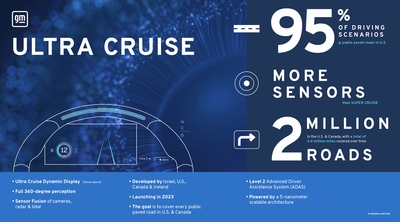GM Brings Powerful New Compute Architecture to Ultra Cruise to Help Enable Door-to-Door Hands-Free Driving
SEE ALSO: U.S. Secretary of Transportation Teases Tesla: Autonomous Cars Still Don’t Exist
But First Snide's Remarks:Why do fully autonomous cars need a dashboard display anyway? (msnide@theautochannel.com)
DETROIT, Jan. 6, 2022 -- GM announced this week that its next-generation hands-free driver assist system, Ultra Cruise, will be powered by a scalable compute architecture featuring system-on-chips developed by American semiconductor company Qualcomm Technologies, Inc. GM will be the first company to use the Qualcomm Technologies' Snapdragon Ride™ Platform for advanced driver assistance technology, which features a 5-nanometer Snapdragon™ SA8540P SoC and SA9000P artificial intelligence accelerator.
Ultra Cruise's compute, which is about the size of two laptops stacked together, will first be available in 2023 on the Cadillac LYRIQ and the ultra-luxury, fully-electric Cadillac CELESTIQ. With high performance sensor interfaces and memory bandwidth, it will, in combination with GM's homegrown Ultra Cruise software stack, be key to helping Ultra Cruise achieve an unmatched combination of capability, reliability, predictability and robust door-to-door hands-free driving in 95 percent of all driving scenarios.
"Despite its relatively small size, Ultra Cruise's compute will have the processing capability of several hundred personal computers," said Ken Morris, GM vice president of Electric, Autonomous and Fuel Cell Vehicle Programs. "It will take qualities that have distinguished GM's advanced driver assist systems since 2017 to the next level with door-to-door hands-free driving."
The Ultra Cruise compute will help power GM-developed ADAS software and features, including perception, planning, localization and mapping. These Ultra Cruise capabilities were developed in-house at GM engineering facilities in Israel, the United States, Ireland and Canada. To ensure a robust and predictable system with minimal latency, GM integrated Ultra Cruise's software on an optimal hardware design, overlaying cameras, radar and lidar. This low-level, sensor fusion, which provides excellent detection and classification of data, and Ultra Cruise's software stack are proprietary to GM, not available on the automotive aftermarket.
The Ultra Cruise compute is comprised of two Snapdragon SA8540P SoCs and one SA9000P AI accelerator to deliver key low-latency control functions on 16-core CPUs and high-performance AI compute of more than 300 Tera Operations Per Second for camera, radar and lidar processing. The Snapdragon SoCs are designed with 5 nm process technology, enabling superior performance and power efficiency. The Snapdragon SA8540P SoCs will provide the necessary bandwidth for Ultra Cruise's sensing, perception, planning, localization, mapping and driver monitoring.
"We are very proud of our collaboration with General Motors on one of the industry's first uses of our Snapdragon SoCs in an automated driving system," said Nakul Duggal, Qualcomm Technologies, Inc. senior vice president and GM, Automotive. "Ultra Cruise powered by Snapdragon Ride on Cadillac vehicles will be an experiential and technological leap forward for the industry."
Along with Snapdragon Ride SoCs, which are designed to meet automotive system safety standards with multiple redundancies built in, the compute includes an Infineon Aurix TC397 processor for system safety integrity. The Aurix TC397 is categorized ASIL-D – the highest Automotive Safety Integrity Level.
GM minimized complexity within the compute, opting for an air-cooled instead of liquid-cooled system that avoids heavy and inefficient thermal cooling lines throughout the vehicle, made possible by Snapdragon Ride's high-performance, high-efficiency design.
Ultra Cruise's compute will also have the capability to evolve over time by leveraging Snapdragon Ride's SoCs performance and high-speed interfaces for future expansion, as well as over-the-air software updates enabled through the Ultifi software platform and GM's Vehicle Intelligence Platform electrical architecture.
General Motors is a global company focused on advancing an all-electric future that is inclusive and accessible to all. At the heart of this strategy is the Ultium battery platform, which will power everything from mass-market to high-performance vehicles. General Motors, its subsidiaries and its joint venture entities sell vehicles under the Chevrolet, Buick, GMC, Cadillac, Baojun and Wuling brands. More information on the company and its subsidiaries, including OnStar, a global leader in vehicle safety and security services, can be found at https://www.gm.com.
Qualcomm, Snapdragon and Snapdragon Ride are trademarks or registered trademarks of Qualcomm Incorporated.
Snapdragon Ride is a product of Qualcomm Technologies, Inc. and/or subsidiaries.



